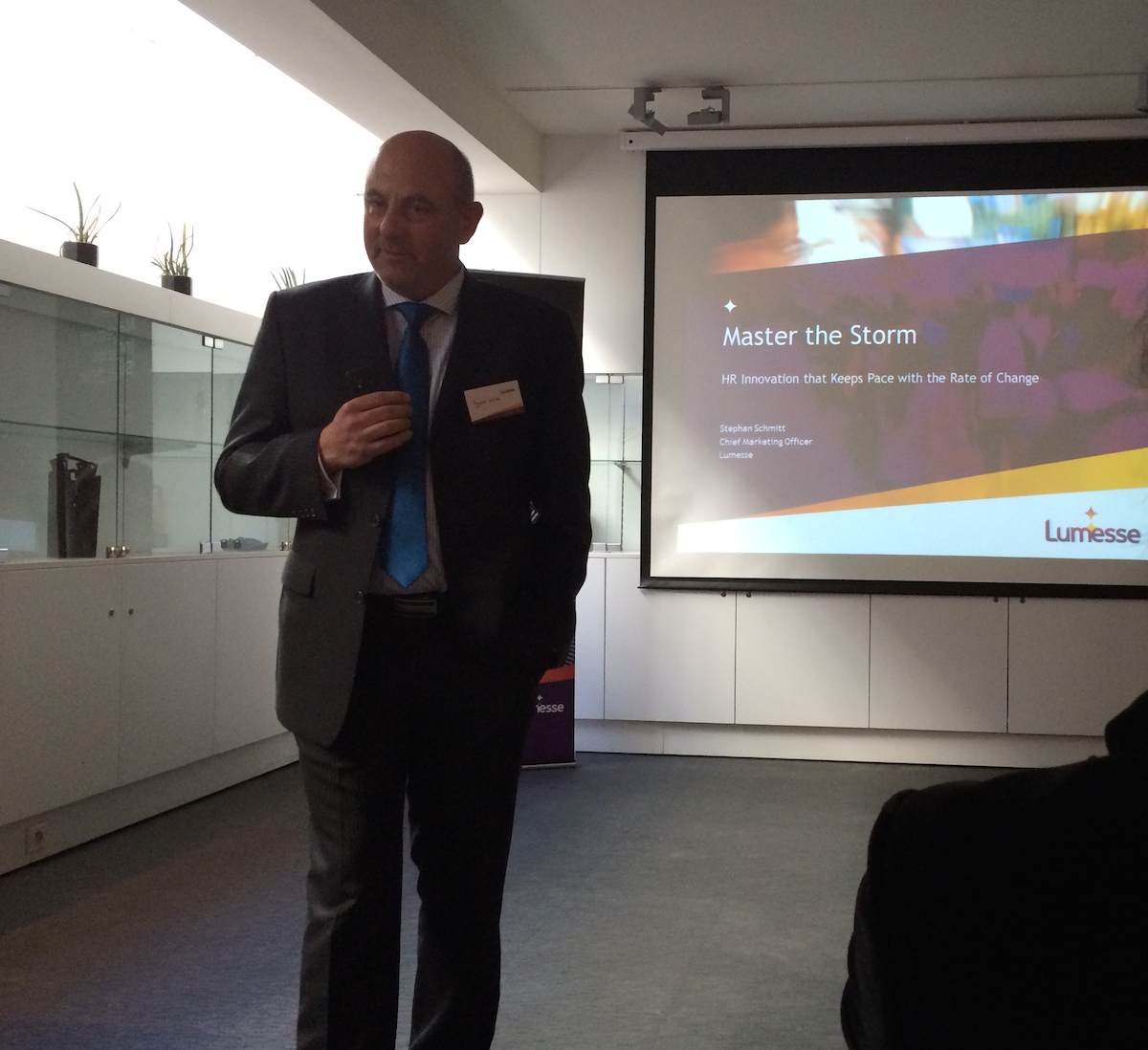On May 16,2014, Lumesse organized a conference about the talent management innovation, the global human trends and the challenges of the human resources. Thomas Volk, CEO ; Guy Aguera, Partner at Deloitte-Consulting ; and Stephan Schmitt, CMO, spoke at the conference.

Facing the storm of talent management
We, the HR community, had better step up, or else.
In the last 5 years, when we talk about the biggest change in HR domain, it has to be the fact that a complete execution depends on resources and talents recruited for the company. The disruptive technology guarantees that we get big data and help indicate progress by talents, or indicate the lack of leadership.
Market disruptions are commonplace, driven by empowered consumers
In 2004, the iPod changed the IT domain because we never thought about connecting this kind of device to a phone. In 2009, technology makes us more efficient when we work at home than we work at the workplace. So the big change is that PC and Internet have allowed us to build communication within the company and with other companies. Working at home, we already have access to the Internet, we can collaborate, we can then put them on the web; we don’t need to be “physically” together to make our work effective and productive.
This latter phenomenon will be easier to understand if it’s related to the social psychology findings. People often think that when we form a group and work together, we can get more effectivity. While the social psychology findings showed that the type of the task, the structure and size of the group, the communication network, the procedures of the task, and the leadership all strongly influence what a group of people outputs. So it is hard to tell if one working individually is worse for the whole carry-out of the task given.
There’s nothing more transformative than an idea for which the time is ripe and the barriers are low
What’s important in HR is to develop talent to be productive, innovative, all based on the new technologies. In order to work with all talents, we need to introduce new technologies because it helps us to find better talents through Internet and do it faster. People learn better when they get information in the same time.
According to Thomas Volk, a)to have top talent; b)to develop leaders, which is important to build the mark of an organization; and c)to build an agility advantage are nowadays the business imperatives for HR.
Leadership: key topic, retention, HR skills, talent acquisitions
The trends according to the Global human capital trends survey are : Lead and Develop ; Attract and Engage ; Transform and Reinvent.
Organizations are struggling to keep up.
Why is it important? Because if we want to perform the organization, we’ll need to perform employees, and to make them engage in the organization’s activities. So we have to give them the ability to develop themselves. What we can offer to the employees is to let them use the best technologies to organize business.
- Performance management is broken: replace “rank and yank” by coaching and development; the first strategy apparently damages employees’ engagement and their high performance, but the second values time.
- Talent acquisition revisited: deploy new approaches for the new battlefield which is shaped by the new global talent network and social media.
- Beyond retention: build passion and purpose, which is the number 2 priority rated by executives around the world; and find a place where they can find themselves a role to play.
- The overwhelmed employee: simplify the work environment. Too much technology and too much information undermine the productivity, so the employees can’t focus on work; they need to be trained to be more productive at the same time. HR managers should try to find a balance between these two factors.
- The reskilled HR team: transform HR professionals into skilled business consultants. They need to adapt employees to working tools, technology, and then value them.
- Talent analytics in practice: go from talking to delivering on big data. HR analytics could help organization to select information and bring back its values. HR platforms should be integrated as “system of management”.
- Global and local HR functions: balance scale and agility. These two HR functions need to be consistent despite the big gap between the will to change and the HR actuality. The HR used to be under-seen, but nowadays, it has to change: 81% of large organizations report that implementing one HR global operating model is “urgent” or “important” today. The development of the new technologies urges this change. And don’t forget the expectation of the talents who demand HRs to be innovative; the talent management has been the first priority for 3 years. 10 years ago the HR community is more of an administration thing, now it becomes business staff and is driven by technology.
Master the storm: HR innovation that keeps pace with the rate of change
“It’s not the strongest of the species that survives, nor the most intelligent, but rather the one most adaptable to change”.

Talent management solution gap
There were 2 former generations of the talent management: the TM 1.0 is a Product Silo ; the TM 2.0 is an Organic Talent Management Suite. The reason why the talent management could not continue using these solutions is that we had to compromise between the innovation and the integration of the employees; we all know that more an organization is integrated, less it is innovative because once you want to make some changes, you have to make all move.
And now we are at talent management 3.0, which is qualified as an “Open Platform As a Service”, with the co-existence of best access to innovation and great integration.
The core of the Talent Management are: highly configurable recruiting, being the foundation; learning; performance; compensation; and succession management. Once these are built on a platform, with the help of open-API, the organization will be allowed for fast integration of third party solutions including other vendor modules; but still, it requires integrating skills.

HireVue: Digital Interviewing Tech
For a better combinaison of the HR theory and product, we got introduced to HireVue, a video recruiting software which allows the HR recruiters to pre-select the candidats for the upper level managers, and spend less time on this procedure compared to a traditional face-to-face job interview.
What’s more, with the software program, the engagement, the motivation, the distress, the personality style of the candidates are automatically calculated for the recruiter. We all know from the findings on social psychology that when a candidate is interviewed, the recruiter « suffer » some psychological bias such as bias related to the expectations of the recruiter, the stereotypes, the effect of demographic similarity, the explanation of behavior standards (i.e,, how we explain and interpret the showed-up behavior), etc. When we do all these analysis with the software, the perception of the recruiter can no more influence this selection procedure; the candidates will be standing at the same starting point and will be selected only based on their performance for the job application.
After the summit, we had the occasion to interview Mr. Stephan Schmitt, Chief Marketing Officer, and Mr. Eric Gellé, the Regional Director Western Europe Lumesse. They kindly answered our questions.
Lumesse, founded as an HR company, are dedicated to promote the influences and the importance of human resources in a company ; and due to his strong local team in every country, Lumesse has the ability to localize the recruitment process, the management, and to help realize a better implemention of all these, which makes the uniqueness of this HR service and platform company. Not only do they engage in the HR process and offer the service, but they also provide the software that fits in their clients’ demands, in other words, they help their clients to use open platform to choose better strategy from 100 possibilities.
From the empirical psychological studies we know that it is possible to consider training as part of the socialization process. Also, it is important to consider training and its evaluation as an intervention that affects the lives of people in work organizations. Thus, Lumesse proposed the peer-to-peer training instead of top-down training because of the first one’s effectiveness.
—————————–
Authored by :
Huansha YIN
Char gée de communication et de marketing (stagiaire) chez SpotPink. Je suis actuellement en Master 1 de Psychologie, Environnement et Menaces Sociales à l’université Paris Descartes. Véritablement intéressée par le domaine de la communication, j’explore ce sur quoi peut intervenir la psychologie dans ce domaine. Passionnée de cinéma et de voyage, j’aime faire la découverte de nouvelles cultures et de nouvelles langues. Vous pouvez me contacter via mon compte Twitter : @HuanshaYin, ou via mon profil LinkedIn.
gée de communication et de marketing (stagiaire) chez SpotPink. Je suis actuellement en Master 1 de Psychologie, Environnement et Menaces Sociales à l’université Paris Descartes. Véritablement intéressée par le domaine de la communication, j’explore ce sur quoi peut intervenir la psychologie dans ce domaine. Passionnée de cinéma et de voyage, j’aime faire la découverte de nouvelles cultures et de nouvelles langues. Vous pouvez me contacter via mon compte Twitter : @HuanshaYin, ou via mon profil LinkedIn.
